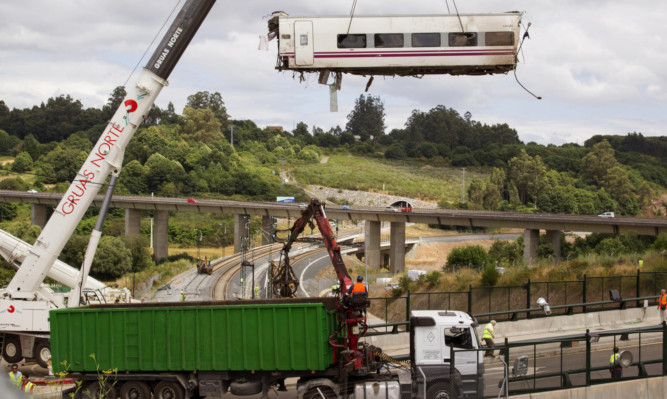Spanish authorities are investigating the driver of the train that crashed in north-west Spain killing 80 passengers in the country’s worst rail disaster for 70 years.
Investigators are looking into possible failings by the driver after the Madrid to Ferrol service derailed on Wednesday night as it approached the city of Santiago de Compostela.
A second probe launched into the catastrophe will look at the train’s in-built speed regulation systems. Early indications suggest the train reached 118mph – more than twice the 50mph speed limit – when it crashed while heading into a curve.
The train’s driver, named in local reports as Francisco Jose Garzon Amo, is expected to be interviewed by an investigating judge in possession of the train’s “black box” data recorder. He is not believed to be under arrest at this stage.
One Briton has been confirmed by the Foreign Office to be among 168 injured passengers, while the regional government in Galicia said it had so far only been able to confirm the identities of 67 bodies.
The authorities were still working to identify the other 13.
DNA tests are expected to be carried out on those with catastrophic injuries to identify them, with results available in the coming days.
A US woman killed in the wreck has been named by Catholic Church officials in America as Ana Maria Cordoba, an employee of a diocese near Washington DC, the Associated Press reported.
Ms Cordoba’s husband and daughter were injured in the disaster as the family travelled to visit her son who had completed a pilgrimage to Santiago de Compostela, the Catholic News Service reported.
President Barack Obama said in a statement: “Today the American people grieve with our Spanish friends, who are in our thoughts and prayers.”
Meanwhile, more than 30 people including four children remain in a critical condition, according to reports.
Many of those on the train would have been pilgrims travelling to Santiago’s St James’ Day festivities, which celebrate the disciple of Jesus whose remains are said to rest in a shrine.
Visiting the hospital in Santiago where most of the wounded are being treated, King Juan Carlos said: “All I can say is that all Spaniards are united in this moment and we are with the victims, with the families and with the friends of the victims.”
Many questions remain unanswered about what went wrong, with some experts claiming that high speed alone would not explain the crash and speculation that the train’s braking systems might have failed.
As the country mourned, Spanish media reported boasts Mr Garzon Amo allegedly posted on Facebook about how fast he was driving a train in March last year.
The 52-year-old, who together with a second driver survived the crash and is being treated in hospital for minor injuries, allegedly posted a picture of a train speedometer at 200kph (124mph). His Facebook page has since been blocked.
“What a blast it would be to go parallel with the Guardia Civil (Spanish police) and go past them triggering the radar. Haha what a fine for Renfe (Spanish rail operator) haha,” he allegedly wrote.
Mr Garzon Amo is a 30-year employee of Renfe who became an assistant driver in 2000 and a fully qualified driver in 2003.
He is believed to have taken control of the train from a second driver about 65 miles south of Santiago de Compostela.
According to reports, one of the drivers realised what was about to happen before the crash and made a desperate call to Renfe ahead of the bend, saying: “I’m going at 190kmh, I’m going to derail.”
In a second call to Renfe after the accident, the driver explained that he was trapped in the train.
“We are human, we are human,” he is reported to have said. “I hope there are no dead because they would fall on my conscience.”
With the dead being taken to a makeshift morgue set up in a Santiago indoor sports arena, Spanish prime minister Mariano Rajoy, who was born in the city, visited the crash scene and declared three days of national mourning.
He said judicial authorities and Spain’s Public Works Ministry had launched parallel investigations into what caused the crash.
The full horror of the disaster was revealed in harrowing video footage of the moment the high-speed train derailed.
Posted on YouTube, the security camera footage shows the middle carriages of the Class 730 train smash into a wall before the engine crashes on to its side.
The derailment left a scene of devastation, with toppled and smashed carriages lying alongside the track, bodies being laid out beside the line, and bloodied survivors being carried to safety.
Alberto Nunez Feijoo, president of the regional government of Galicia, described the scene as “Dante-esque”.
Wednesday’s train crash is the worst Spain has experienced since a three-train accident in a tunnel in the northern Leon province in 1944.
Due to heavy censorship at the time, the exact death toll for the Torre del Bierzo disaster has never been established.
The official figure was given as 78 dead, but it is thought that as many as 250 could have been killed.
There was another serious accident in Spain in 1972 when a Madrid to Cadiz express collided head-on with a local train on the outskirts of Seville. A total of 77 people died, with more than 100 injured.
The latest incident comes less than two weeks after six people were killed and scores injured in a train crash just south of Paris.
